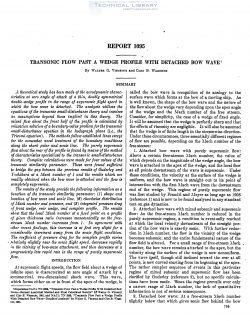naca-report-1095

- Version
- 160 Downloads
- 3.58 MB File Size
- 1 File Count
- September 7, 2016 Create Date
- September 7, 2016 Last Updated
National Advisory Committee for Aeronautics, Report - Transonic Flow Past a Wedge Profile with Detached Bow Wave

A theoretical study has been made of the aerodynamic charac-
teristics at zero angle of attack of a thin, doubly symmetrical
double-wedge profile in the range of supersonic flight speed in
which the bow ware is detached. The analysis utilizes the
equations of the transonic small—disturbance theory and inmlres
no assumptions beyond those implicit in this theory. The
mixed flow about the front half of the profile is calculated by
relaxation solution ofa boundary—value problem for the'tra-nsonie
small-disturbance equation in the hodograph plane (i.e., the
Tricomi equation). The methods follow established lines except
for the some-what novel treatment of the boundary conditions
along the shock polar and sonic line. The purely supersonic
flow about the rear of the profile is found by means of the method
of characteristics specialized to the transonic small-disturbance
theory. Complete calculations were madefor four values of the
transonic similarity parameter. These were found suficie-nt
to bridge the gap between the previous results of Guderley and
Yoshihara at a M'ach number of 1 and the results which are
readily obtained when the bow ware is attached and the flow is
completely supersonic.
The results of the study provide the followi up information as a
function of the tra-nsonic similarity parameter: (I) shape and
location of bow ware and sonic line. (2) chordwise distribution
of M’ach number and pressure, and (3) integrated pressure drag
of front wedge, rear wedge, and complete profile. The results
show that the local Jfach number at a fired point on a profile
of given thickness ratio increases 'monotonically as the free—
stream llIach number increases from I. In agreement with
other recent findings, this increase is at first ray slight for a
considerable increment away from, the sonic flight condition.
The. coeficient of pressure drag for the complete profile caries
relatively slightly near the sonic flight speed. decreases rapidly
in the vicinity Qf'bow-ware attachment, and then decreases at a
progressicely less rapid rate in the range of purely supersonic
flow.
| File | Action |
|---|---|
| naca-report-1095 Transonic Flow Past a Wedge Profile with Detached Bow Wave.pdf | Download |

Comment On This Post